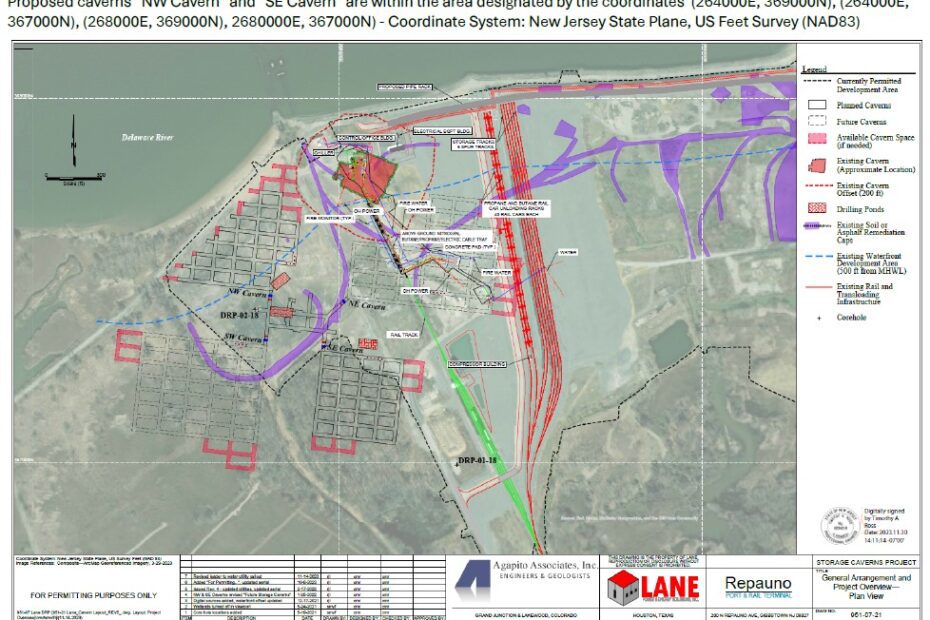New Jersey Department of Environmental Protection (NJDEP) issued a draft permit to Delaware River Partners for two new massive underground storage caverns at their Repauno (Gibbstown Logistics Center) site on the Delaware River to store liquid gases.
>>> Read a copy of the proposed draft permit.
Public Hearing
NJDEP will be holding a public hearing on Wednesday, May 14th regarding the draft permit for this site. Please attend—you can speak in person or virtually.
Wednesday, May 14th, 6:00pm – until last speaker or 9:00pm
St. Michael’s Mutual Club Event Hall,
406 Memorial Ave., Gibbstown, NJ 08027
For both in person or virtual, register with DEP here: https://forms.office.com/g/BhAtWfcbQs
You may use any of the talking points at the bottom of the page to help craft your public comment.
Written Comments
NJDEP is currently accepting comments regarding the draft permit until June 16. Here are three ways you can comment.
Form Submission
Simply use our form below to submit a comment. You may edit and modify the suggested text or use any of the talking points at the bottom of the page to help craft your comment.
Direct Email
Send your own email to tcpa@dep.nj.gov.
Use the subject line: Underground Storage Cavern draft permit to construct comments
via Post Mail
Mail your comment to:
ATTN: Quddus Qayyum
Bureau of Release Prevention, DEP
401 East State Street, 4th Floor,
Mail Code 22-03D, PO Box 420,
Trenton, NJ 08625-0420
Some suggested talking points for the public hearing and/or your written comment:
Re: Underground Storage Cavern draft permit to construct comments, Repauno/Gibbstown
I oppose the construction and use of underground storage caverns for liquid gas as described in the Draft Permit issued for the Repauno site at Gibbstown, NJ. I request that NJDEP deny the draft permit.
The overall risks are too great to permit caverns at this location. The region is densely populated, including environmental justice communities already overburdened with pollution and a degraded environment; infrastructure, sensitive facilities and river marine traffic are adjacent; the Repauno site is crowded with other dangers such as above ground gas storage, rail and truck traffic, and gas liquid transloading operations; and the site is on the Delaware River where vulnerable ecosystems and species live; and it’s next to or within the 500-year floodplain, subject to flooding, sea level rise and storm surge.
The construction impacts are unacceptable. The construction of the caverns will impact the region’s population and environment due to blasting, drilling, trucking, diesel equipment operation, disturbance of existing contaminants on the site, and destruction of natural features such as wetlands and water resources. The project will require THREE YEARS of construction, day in and day out. This will be a relentless attack on the area.
The operation of these caverns will be polluting. These enormous caverns will vent and/or flare gases routinely. Air pollutants could include: VOC (Volatile Organic Compounds), NOx (Oxides of Nitrogen), CO (Carbon Monoxide), SO2 (Sulfur Dioxide), TSP (Total Suspended Particulates), PM10 (Particulate Matter ≤ 10 microns), Lead, Hazardous Air Pollutants and more. When flared, liquid petroleum gases emit poisonous gases, including Carbon monoxide, Hydrocarbons, and Nitrogen oxides (see: https://www.nettinc.com/information/emissions-faq/what-are-lpg-emissions). We cannot tolerate any more air pollution here!
Liquid Petroleum Gases threaten catastrophe. The gases that would be transported in, deposited, stored, and removed for export and sale are very difficult to safely handle. They are highly flammable, can cause explosion and/or fire, and the massive volume that will be stored here would be catastrophic if uncontrollably released. When these gases are burned in a fire, they release hazardous gases that have damaging health effects. The fire is difficult to put out; fire codes say to evacuate at least one mile. The gas is heavy and can move in a cloud far from the source of the release and explode or flash back to the source. The released gas can cause frostbite and rob oxygen from the air, causing death by suffocation for those nearby. People live, work, and recreate, go to school and conduct business just a mile from these caverns. This is far too dangerous to allow.
Caverns can leak hazardous materials into the groundwater. These gases have hazardous and/or toxic properties that can leak into the groundwater through the cavern walls and pollute aquifers that we rely on for water supplies. The gases can also contaminate the adjacent Delaware River, waterways and soils. All these gases are classified as hazardous. Some gases have serious adverse health effects such as developmental and reproductive toxicity (see: Safety Data Sheet Number888100004454, Tesoro, 2018 https://www.marathonpetroleum.com/content/documents/Operations/Tesoro_SDS/LPG_SDS_Tesoro.pdf). Preventing such pollution is the most effective way to protect water quality and the environment.
The site is already contaminated by Dupont. This site is still undergoing clean up by Chemours due to over a hundred years of Dupont manufacturing munitions here. This site should not be further disturbed when the groundwater has not been fully cleaned up and the site is still under remediation. Construction activities required to build the caverns are located on already capped remediation areas and could cause pollutants to migrate in groundwater and/or runoff to surface water/the river, spreading contamination. Why allow interference with the cleanup of a grossly polluted site?
More caverns? Yes, Delaware River Partners shows on their project map two more caverns they plan to build on the site. Yet the Environmental and Health Impact Statement required by DEP (this is the first application under the new cavern rules adopted by DEP) only looks at these 2 caverns, obstructing an assessment of the cumulative impacts of the entire project. The environmental impacts will be looked at piecemeal, not as a whole. DEP must consider all of these caverns at once in order to accurately and comprehensively assess the impacts. The caverns will require a new air permit and a Toxic Catastrophe Protection Act approval, among other permits. All permits must be evaluated at once with a facility-wide environmental impact review. Don’t allow segmentation of an even larger development project – that trick has long been used to artificially minimize the impacts on public health and the environment!
What REALLY will these caverns be used for? Precisely what gases will be transported into, handled, stored, and exported from these caverns is not clearly stated in the permit application and the cavern rule definition is full of holes. Delaware River Partners says the gases “will include” Butane, Propane, and Propylene – but not that these will be the only gases. Some gases are more toxic than others, some have different properties and risks, some synthetic gases are not fully studied or understood. While DEP correctly prohibits the storage of Liquefied Natural Gas (LNG) in caverns, it doesn’t rule out highly problematic gases, including carbon or hydrogen. The proposed MACH2 Hydrogen Hub actually lists the Repauno site as a possible component of the Hub, although the use has not been disclosed by MACH2. When you think hydrogen, think of the Hindenburg disaster, which famously exploded just southeast of this location in South Jersey. We want to know what the properties of the stored gases are and the potential impacts on public health and the environment BEFORE any permit is authorized.
How many projects can you squeeze onto one plot without flirting with disaster? Delaware River Partners still plans to build the Gibbstown Liquefied Natural Gas (LNG) Export Terminal on this same site, entailing a 2-berth “Dock 2” wharf, truck and rail transloading equipment, a huge railyard system, and associated infrastructure – a massive project that would operate 365 days per year, handling one of the most notoriously dangerous fossil products – LNG. Yet there’s no consideration of how all these projects on this one site would interact with each other, including if there is a release of gases. And they say they plan to build it over the next three years, just when these caverns would be under construction!
What about the rock and soil they remove? Excavated soil/rock may contain pollutants such as radioactivity and asbestos, when brought to surface. Delaware River Partners plans to spread the rock and soil on the property to elevate it above the floodplain. Filling in the floodplain is a bad idea because of numerous negative environmental impacts, but to use material that could contain contaminants and not require thorough and ongoing testing of what they mine is irresponsible. They also plan to make an enormous waste pile which would be located in what is called the “nitrobenzene area”, where this toxin was found during remediation. Will the pile and hundreds of trucks dumping the material there stir up the contaminant? It’s also partially on a “Tier 3 wellhead protection area” for the Gibbstown public water supply. Will the well be impacted by leaching from the pile (despite the planned “cap”)? It’s also next to wetlands and could cause sediment and contaminant-laden stormwater to runoff into adjacent surface water, polluting the tributaries and the river. All excavated materials and the area where it would be placed must be fully tested for contaminants before being used in any way, not the proposed limited sampling. The stockpiled material cannot be located near wetlands, wellheads, or water bodies. We cannot tolerate any more contamination here!
Drilling chemicals and waste imperils water. Shafts will be drilled from the surface 600 feet down, where the caverns will be blasted out of the rock. The fluids used in drilling and the waste produced endangers water quality and soil. Chemical additives, sometimes called “drilling muds,” are used to lubricate the drill bit and to remove rock cuttings. As per a 2018 report: “Drilling chemicals have received less scrutiny than chemicals used for hydraulic fracturing (“fracking”) or well stimulation, but EPA has expressed concern that drilling chemicals can have health impacts including blood toxicity, developmental toxicity, kidney toxicity, liver toxicity, and neurotoxicity. One particular area of risk is during the initial drilling when companies often bore directly through groundwater before installing any protective casing or cement. During this phase, chemicals could leach directly into water supplies.” (see: “Keystone Secrets: Records Show Widespread Use of Secret Fracking Chemicals Is a Looming Risk for Delaware River Basin, Pennsylvania Communities”, Dusty Horwitt, Partnership for Policy Integrity (PFPI), September 11, 2018.) Delaware River Partners plans to hold the drilling wastes in a pond, then cover it on site. This is not acceptable. The muds must be segregated from the environment, tested for polluting properties, and disposed of properly, which may require hazardous waste disposal. Don’t dump toxic muds on us!
Protect the Delaware River’s life. Cavern construction, storage and the associated operations pose serious environmental impacts for the Delaware River, adjacent streams and waterways, and wetlands; threaten the unique breeding grounds/habitats on the unused portion of the Dupont property and adjacent open space and parkland (i.e. Munds Island); and jeopardize fish, aquatic life and wildlife, including the federally endangered Atlantic sturgeon and protected bald eagle and osprey, all of which have documented habitat here. The climate is in crisis! We have the responsibility as a state to consider the climate impact – upstream and downstream, cradle to grave – of all projects approved here. Petroleum gases are fossil fuels that release greenhouse gases throughout the entire life cycle including when extracted, while stored, contained in infrastructure, being transloaded, transported and finally when used. There is no requirement for this draft permit to consider the full climate impacts of the gas’s life cycle. This is unacceptable and irresponsible of DEP!

